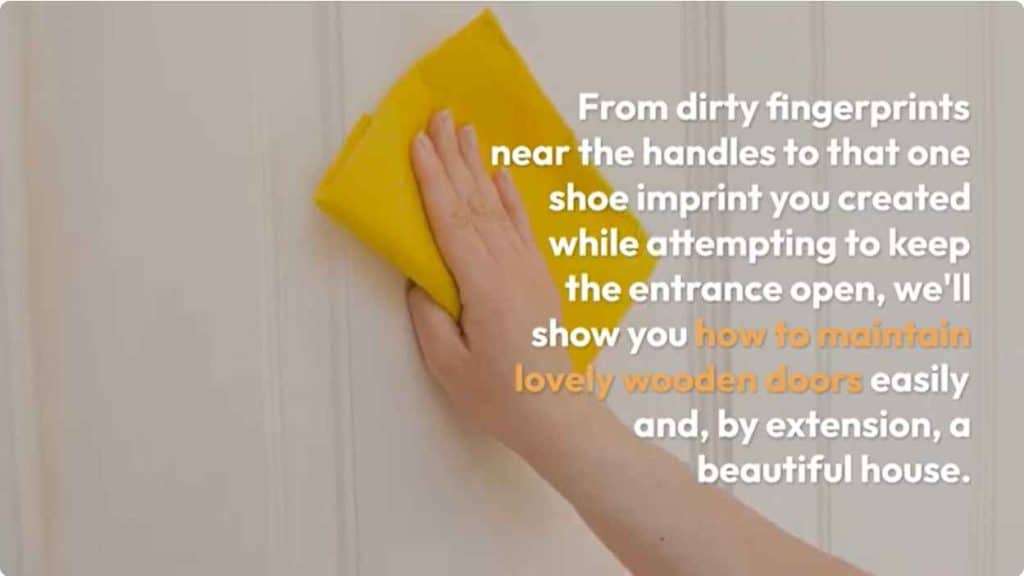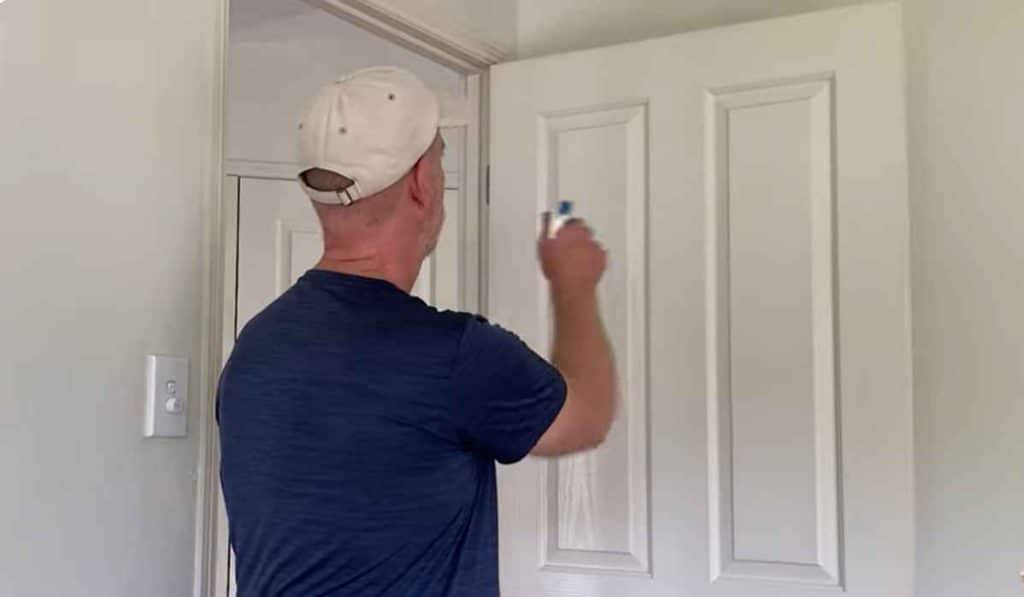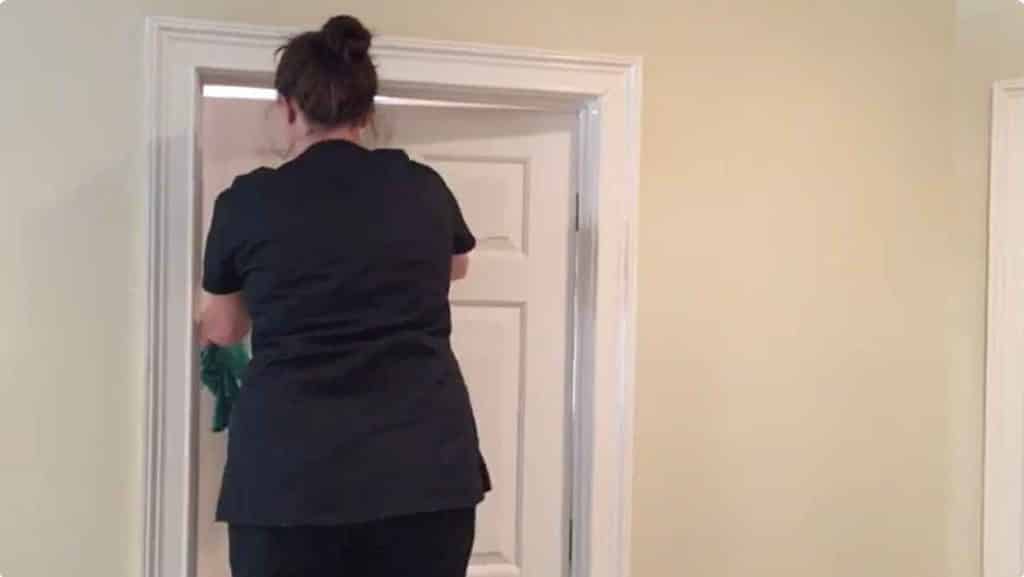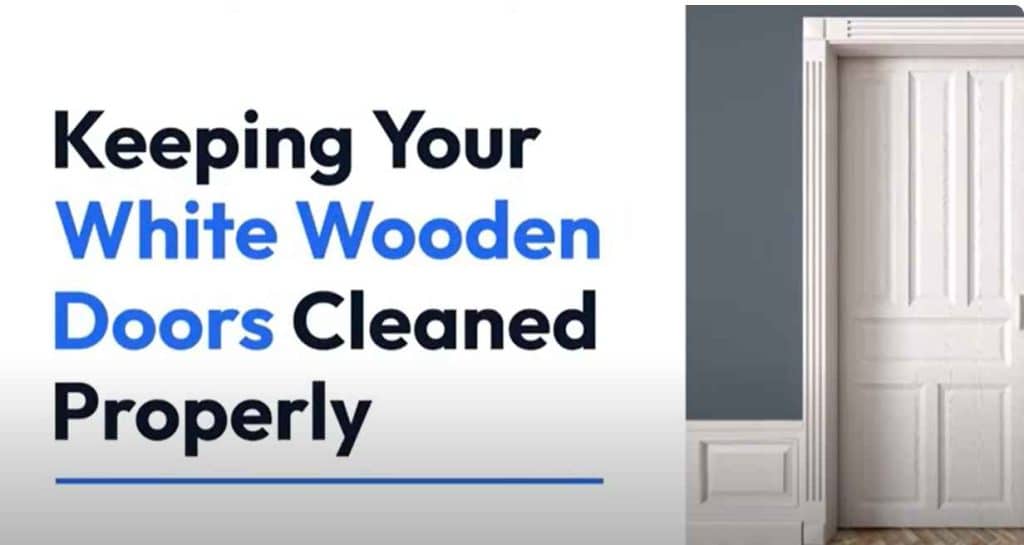Clean white doors that have gone yellow by using a mixture of warm water and baking soda. Apply it gently with a soft cloth, then rinse and dry.
Keeping white doors spotless and bright can be challenging, especially when they start to turn yellow over time.
This discoloration is often due to sunlight exposure, dirt buildup, or the aging process of certain paint types.
Homeowners and property managers searching for effective cleaning methods need solutions that are simple, affordable, and safe for their doors’ material.
A fresh, clean door enhances the aesthetic of your interiors, making maintenance an essential aspect of property care.
The following content provides a practical guide on restoring white doors to their pristine condition using common household items.
Introduction To Yellowing Of White Doors
White doors add a bright and clean look to any room. Over time, these doors can start to turn yellow. This can make your once pristine home look worn and uninviting.
We will learn how to get them back to bright white.

Understanding The Causes Of Yellowing
The yellowing of white doors is a common issue. Many factors can change the color of your doors. Here are the main culprits:
- Age: Over the years, paint breaks down and may be yellow.
- Smoke: Tobacco or cooking can stain your doors.
- Cleaners: Some chemical cleaners may cause discoloration.
- Sunlight: UV rays can change the paint’s color over time.
The Impact Of Environmental Factors On White Doors
Your doors live with you. Like skin, they face the environment head-on. Here’s how the world around you can affect your doors:
| Environmental Factor | Impact on Doors |
|---|---|
| Direct Sunlight | Can cause the door to yellow faster. |
| Humidity | May lead to mold that makes doors look dirty. |
| Dust and Dirt | Regular build-up can spoil the door’s appearance. |
| Indoor Heating | Heat can accelerate the yellowing process. |
Preparatory Steps Before Cleaning
White doors add elegance to your home. But over time, they can turn yellow. To bring back their shine, you need the right approach. Follow these simple steps before you start. Your doors will look as good as new!
Gathering Necessary Cleaning Supplies
Get all your cleaning materials ready:
- Soft cloths or sponges
- A bucket of warm water
- Mild detergent or soap
- Baking soda for tough stains
- Rubber gloves to protect your hands
- Vinegar for a homemade cleaning solution
Mixing vinegar and water creates a powerful, natural cleaner.
Protecting The Surrounding Area
Before you begin, protect your floors and walls:
- Place old towels or newspapers around the door.
- Use masking tape to cover areas you don’t want to clean.
- Keep your workspace well-ventilated.
This prevents unwanted damage and makes your job easier.

Cleaning Solutions For White Doors
White doors add elegance to your home. Over time, they may turn yellow. Knowledge of the right cleaning methods is crucial. Let’s explore some effective cleaning options.
Homemade Remedies Vs. Commercial Cleaners
Choosing the best cleaner can be a challenge. Here, we’ll compare homemade remedies to commercial cleaners. Both can be effective, but they offer different benefits.
| Homemade Remedies | Commercial Cleaners |
|---|---|
| Vinegar and baking soda mixture | Branded door cleaners |
| Safe for kids and pets | Powerful against tough stains |
| Cheap and readily available | Convenient and timesaving |
Homemade solutions often include vinegar or baking soda. These are safe and gentle. Commercial cleaners offer more power. They work well on stubborn stains.
Eco-friendly Options For The Environmentally Conscious
If you care about the planet, choose eco-friendly cleaners. They keep your doors and earth safe.
- Use natural ingredients like lemon and olive oil.
- Avoid harsh chemicals to protect the environment.
- Check labels for eco-friendly certifications.
Some green products are available in stores. You can also make your own. A simple mixture of vinegar and water works wonders.
Step-by-step Guide To Cleaning Yellowed White Doors
Your once pristine white doors have developed a yellow tinge. Fear not! Follow this simple guide to restore their former glory.
A door’s appeal lies in its clean, crisp appearance – essential for first impressions. Let’s dive into the cleaning process.
Initial Wiping And Dusting Techniques
Start with the basics: dusting and wiping. This process eliminates loose dirt and prepares the door for a deep clean. Use the right tools and methods for effective results.
- Grab a microfiber cloth: It’s gentle and traps dust well.
- Dust top to bottom: Gravity helps drag down the dust.
- Target corners and crevices: Dirt loves to hide here.
- Gently wipe: Apply minimal pressure to avoid scratches.
Applying The Cleaning Solution
Now, prepare a safe yet powerful cleaning mixture to tackle the yellowing. A homemade solution can be just as effective as store-bought products.
| Steps | Instructions |
|---|---|
| Mix your solution | Combine warm water and baking soda. |
| Test on a small area | Check for colorfastness before proceeding. |
| Use a soft sponge | It carries the solution without scratching. |
| Gently scrub | Focus on yellowed spots, but be gentle. |
| Rinse with a damp cloth | Remove any residual cleaner. |
| Dry the door | Use a dry towel to avoid water marks. |
Consistent cleaning can prevent doors from turning yellow again. Embrace these simple steps, and your doors will shine white in no time!

Advanced Cleaning Techniques
When it comes to advanced cleaning techniques for white doors that have yellowed, a methodical approach can work wonders.
Over time, white doors can lose their luster and brilliance, taking on a yellowish tinge due to sunlight exposure or the aging of certain paints and varnishes.
This section will guide you through some strategic, targeted cleaning methods designed to tackle stubborn stains and restore your white doors to their former glory.
Dealing With Stubborn Stains
Stubborn stains require special attention. The following tips are effective ways to treat these problem areas:
- Magic Erasers: These can be invaluable for scrubbing off tough stains.
- Baking Soda Paste: Mix baking soda with water to create a thick paste, apply to the stain, and gently rub.
- Vinegar Solution: White vinegar can dissolve grime. Mix it with water and use it to wipe down the door.
- Commercial Cleaners: Use these as directed for more persistent discoloration.
For any product, always test a small, inconspicuous area first. This ensures it won’t damage the door’s finish.
Polishing And Finishing Touches
After eradicating stains, the next step involves polishing and adding finishing touches to your white door:
- Clean the door with a damp cloth to remove all cleaning product residues.
- Let the door dry completely before proceeding.
- Apply a thin coat of car wax or furniture polish to add a protective layer and shine.
- Buff the door with a soft, dry cloth to achieve a smooth, even finish.
| Product Type | Application Method | Expected Result |
|---|---|---|
| Car Wax | Apply thinly with cloth | Glossy Shield |
| Furniture Polish | Spray and Buff | Restored Shine |
Remember: Regular maintenance ensures your white doors stay sparkling clean year-round.
Maintenance Tips To Prevent Yellowing
Keeping white doors pristine requires ongoing attention. Effective maintenance minimizes yellowing. This section covers practical steps to maintain white doors.
Regular Cleaning Routine
Consistency is key for white door upkeep. A weekly cleaning routine prevents buildup. Note these steps:
- Wipe surfaces gently with a mix of warm water and mild dish soap.
- Use a soft cloth to avoid scratching the door.
- Dry immediately with a clean towel to prevent water spots.
Pay special attention to door handles and edges. These areas collect the most dirt and oils.
Protective Measures And Products
Protect your doors beyond regular cleaning. Here’s how:
| Measure/Product | Description |
|---|---|
| UV Protective Sealant | Apply a UV-resistant top coat to shield from sunlight. |
| Avoid Harsh Chemicals | Stick to gentle cleaners to maintain paint integrity. |
| Humidity Control | Use dehumidifiers to reduce moisture that can cause discoloration. |
Implementing these tips aids in keeping white doors bright and welcoming for years to come.

Addressing Severe Yellowing
White doors can turn yellow over time due to sunlight, smoke, or simply age. When doors show severe yellowing, a deep clean might not suffice.
In some cases, repainting the door becomes necessary to restore its bright white appearance.
When To Consider Repainting
Inspect the door for the level of yellowing. If cleaning doesn’t help, it’s time to repaint. Look for signs like stubborn stains or discoloration that won’t go away. Here are clear indicators:
- Deep yellow hues that persist after cleaning
- Uneven color patches
- Visible damage or wear
Choosing The Right Paint For White Doors
Selecting the best paint ensures a lasting, vibrant result. Take these steps:
- Determine the right type of paint such as oil-based or latex.
- Opt for a durable finish like semi-gloss or high-gloss.
- Choose quality brands with good coverage.
Remember to prime the door first for even paint application.
| Paint Type | Pros | Cons |
|---|---|---|
| Oil-Based | Durable, glossy finish | Takes longer to dry |
| Latex-Based | Easy clean-up, dries quickly | Less durable than oil-based |
Alternative Solutions: Covers And Veneers
Sometimes, cleaning might not restore the original shine of white doors. Covers and veneers offer a practical solution to this challenge.
They not only conceal yellowing but also provide doors with a brand-new look. Explore the benefits of door covers and installing new veneers to refresh your home’s appeal.
Door Covers To Conceal Yellowing
Door covers are an instant fix for yellowed doors. They come in various styles to match your interior design. Here is how door covers can benefit your home:
- Easy to apply: They stick right onto the door.
- Variety of designs: Choose from colors and patterns.
- Durable: High-quality covers last for years.
- Cost-effective: Cheaper than buying new doors.
Applying a door cover is straightforward. Clean the door surface, peel the cover, and apply it smoothly to avoid air bubbles. Trim the edges for a perfect fit.
Installing New Veneers For A Fresh Look
Veneers are thin layers of material that attach to the door surface. They are perfect for a long-term solution to door discoloration. Look at the steps to install veneers:
- Clean the door surface.
- Measure and cut the veneer to size.
- Apply adhesive to the door.
- Place the veneer carefully and press down.
Veneers come in wood, laminate, or vinyl options. They make doors appear brand new. Veneers are a smart choice for a sustainable home makeover.
Professional Cleaning And Restoration Services
Professional Cleaning and Restoration Services turn back time on your white doors. They remove the yellow tinge. They restore the original charm.
Professionals know how to handle different materials and paints. This service is perfect for doors past the point of DIY fixes.
When To Hire A Professional
Yellowed doors need expert hands. Consider these scenarios:
- Stubborn stains resist home cleaning
- Door materials are delicate or antique
- Time is scarce
- Desired results need professional-grade tools
What To Expect From Professional Door Cleaning
Professionals follow a methodical process:
- Initial Assessment: Determines the cause of yellowing.
- Cleaning Method Selection: Pick suitable cleaners.
- Treatment Application: Uses non-abrasive techniques.
- Final Inspection: Ensures quality restoration.
Expect a mess-free service. Expect doors to shine. Expect durable results.

The Role Of Ventilation In Preventing Yellowing
Keeping white doors pristine requires more than just cleaning. Ventilation plays a crucial role. Poor airflow can trap pollutants and moisture.
These elements contribute to the yellowing of white doors over time. Good ventilation helps to prevent this. It ensures that doors stay white and fresh for longer.
Improving Air Circulation In Your Home
Airflow is essential for maintaining white doors. Enhanced circulation dilutes the buildup of airborne substances that can yellow doors. Here are simple steps to improve air circulation:
- Open windows daily to create cross-ventilation
- Use ceiling fans to move air even in closed spaces
- Keep internal doors open to allow air to flow freely
- Install vent fans in high moisture areas like bathrooms and kitchens
Taking these steps reduces the chances of doors yellowing. It ensures a cleaner, healthier home environment.
The Benefits Of Dehumidifiers In Moist Environments
White doors in damp areas are more prone to yellowing. Dehumidifiers can help. Here’s how they benefit:
- They lower humidity, making it hard for pollutants to stick
- Dehumidifiers reduce condensation which can lead to yellowing
| Environment | Humidity Level | Dehumidifier Benefit |
|---|---|---|
| Bathrooms | High | Prevents mold that can cause discoloration |
| Kitchens | Moderate to High | Eliminates moist air which can deposit on doors |
By using a dehumidifier, you protect white doors from excess moisture and keep them looking new.
Common Mistakes To Avoid
Cleaning white doors that have yellowed can seem tricky. Make sure to dodge these common mistakes to protect your doors and keep them looking fresh.
Using Harsh Chemicals
Stay away from strong cleaners, such as bleach, when tackling yellowed doors. They can do more harm than good. These solutions might strip the paint and damage the material.
Instead, opt for gentle, soapy water or special wood cleaners. Use a soft cloth to apply the solution, and be gentle to prevent scratching.
Neglecting Follow-up Care
Cleaning is only part of the job. Regular maintenance is key to avoid yellowing in the future. After cleaning, dry your doors thoroughly.
An undried door can lead to moisture buildup, which brings back yellowing quickly. Lastly, apply a door protectant or finish that guards against UV rays. This helps maintain that crisp white look longer.
| Do’s | Don’ts |
|---|---|
| Use gentle cleaners | Apply harsh chemicals |
| Wipe with a soft cloth | Scrub vigorously |
| Dry doors completely | Leave doors damp |
| Use UV protectant finishes | Ignore long-term care |
Conclusion: Restoring The Beauty Of White Doors
Years of exposure can leave white doors yellow and dull. Yet, with the right approach, their original splendor shines again. This guide shared proven methods to address the yellowing challenge confidently.
Summarizing Key Cleaning Strategies
Remember the essentials:
- Soft cloth and mild soap for gentle cleansing.
- Baking soda paste for tough stains.
- Vinegar for safe, natural disinfection.
- Microfiber cloths to avoid scratches.
For severe yellowing, painting may be the best path.
The Importance Of Regular Maintenance
Daily attention keeps doors sparkling.
- Wipe down surfaces weekly.
- Avoid direct sunlight where possible.
- Immediate stain treatment prevents buildup.
Yearly deep-cleaning can maintain a lasting radiance.
With these strategies, yellowed doors transform back into shining portals. They brighten homes and uplift spirits. A commitment to regular care makes this renewal possible and effortless.
Follow these steps to ensure your white doors stay as vibrant as the day they were installed.
Frequently Asked Questions For How To Clean White Doors That Have Gone Yellow
Why Do White Doors Turn Yellow Over Time?
White doors can be yellow due to exposure to sunlight, heat, and airborne substances like smoke and cooking oils. The process is gradual and affects many types of white-painted or plastic surfaces.
What Cleaning Agents Are Safe For White Doors?
For cleaning white doors, gentle agents like diluted dish soap, vinegar, or baking soda paste are safe and effective. Harsh chemicals can damage the door’s finish or material.
Can Repainting Reverse Yellowing On White Doors?
Yes, repainting is a reliable solution for reversing yellowing. Ensure the surface is clean and primed before applying a high-quality, non-yellowing paint designed for doors.
How Often Should I Clean White Doors To Prevent Yellowing?
Regular cleaning, every few weeks, can prevent yellowing by removing buildup. Maintenance helps retain the door’s white appearance and avoids the need for more intense cleaning.
Conclusion
Restoring the bright appearance of yellowed white doors rejuvenates your space significantly. Embrace the simple methods we’ve shared, and you’ll see striking results. Regular upkeep with gentle cleansers prevents discoloration recurrence. Transform your doors back to pristine white and enjoy a fresher, cleaner-looking home.

